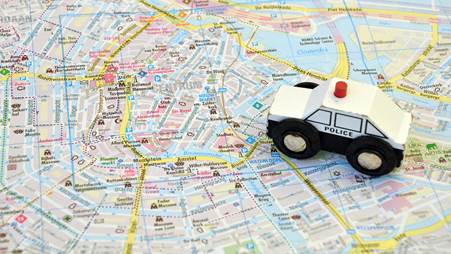A Day In The Life
That’s just the start. In the true age of
the thingternet, every object in your home will be communicating with the
others, building ad hoc networks and self-reporting errors.
Here’s an ideal, and realistic, scenario
for your daily routine. Your calendar syncs with your alarm clock, telling it
when you have to be at work. The alarm checks with weather and transport feeds
to determine if you’re likely to be delayed and adjusts accordingly, comparing it
to previous wake-up times as recorded by wearable sensors. It also turns on the
shower and coffee machine and if it’s hot enough outside, it’ll start your
car’s air-conditioning to cool you down.

It
also turns on the shower and coffee machine and if it’s hot enough outside,
it’ll start your car’s air-conditioning to cool you down.
Taking things a little further, wearable
accessories such as Google Glass could give you an AR-view of the world where
you’ll be able to see information from the connected devices around you,
overlaid on a head-up display. Data from millions of sensors will allow both
individuals and organizations to spot and take advantage of the connections
that only huge amounts of sensor data ‘big data’ can discover.
Things To Come
The thingternet is looking to spread even
further afield, with smart homes already being replicated on a city-wide scale.
In Rio de Janeiro, IBM and Cisco have been establishing a large-scale
infrastructure for a thingternet city. In 2010, the two companies created a
single Operations Centre for the city, which brings together Rio’s public
utilities, traffic management systems and emergency services under one roof.
The facility has 300 LCD screens delivering feeds from 450 cameras, three
helicopters and over 10,000 vehicles. Weather info and simulations as well as
data on disease outbreaks, natural disaster prevention and crime data are all
fed into the system.
Almost every aspect of the city’s
government makes use of the Ops Centre, including energy, education, health,
transport, tourism and housing. But the information isn’t just available to
officials that would be very 1984. Instead residents of Rio can download apps
that make use of the data, or track alerts via social networks.
Rio’s setup is just the start. A wealth of
internet connected objects will increase opportunities for automation: in the
smart city of the future, robots could be dispatched to deal with damaged
roads, clear up spills or put down salt to deal with snow as soon as sensors
pick up on it. Buses and taxis could be dispatched or re-routed to busy areas
while police and health services could be alerted when sensors indicated an
imminent problem.
Dangerous Things
Police are already using the thingternet to
fight crime, Minority Report-style. An LA company called PredPol has tweaked
the algorithms used to predict earthquakes to feed on crime maps and predict
crime hotspots instead. It says the LAPD saw a 36% drop in the crime rate in a
district that used the system. Imagine now if each police officer was wearing a
set of sensors, streaming data to be analyzed and applied.

An
LA company called PredPol has tweaked the algorithms used to predict
earthquakes to feed on crime maps and predict crime hotspots instead.
Of course, just because you can hook up
devices and objects in your life to the web doesn’t mean that you should. To
those of us who like to tinker, imbuing objects with ambient intelligence is
practically irresistible, but science fiction has given us plenty of examples
of why it could be a terrible idea. And not just a murderous HAL9000 there’s
more prosaic pain coming our way.
The most likely daily issue is irritation.
Think about the intelligent doors of the Sirius Cybernetics Corporation in The
Hitchhiker’s Guide to the Galaxy, which are programmed to love their jobs to an
infuriating extent. Similarly, we should work hard to avoid kitchen gadgets of
the future going the way of the monomaniacal Talkie Toaster in Red Dwarf, whose
defective personality causes him to steer every conversation on to the topic of
toast.
Secure Geeking
More seriously, the security of homes and cities using
internet-connected objects is going to be a major challenge. Already, smart energy meters, one of the first mainstream
applications of thingternet principles, are being targeted by hackers. When we
begin to connect our homes, cars and entire cities, the temptation for hackers
both inquisitive and malicious will be huge. Home hookups such as Control4’s
automation (see above) make life more convenient, but the specter of
large-scale attacks on connected electricity or transport systems looms. As far
back as 2009, security firm IO Active demonstrated a worm designed to spread
through a smart grid, disabling or taking control of meters as it went. In the
massively connected future, a malware attack could send a whole country dark.
The cyber-security world was captivated by 2010’s Stux net, a worm that
attacked specific components at Iranian nuclear plants. Inevitably, as
automation and internet connected objects become more main stream, so will
attacks. Then there’s the issue of offering up all that data to make our lives
easier – it opens up privacy concerns that would give even Mark Zuckerberg a
migraine.

More
seriously, the security of homes and cities using internet-connected objects is
going to be a major challenge.
A New Thingternet Age
So will the thingternet become as dominant
as the internet that gave rise to it? Well, it’s not a question of if, but of
when. Major companies, start-ups and individual inventors are all turning their
attention to getting objects online and talking to each other. Very soon the idea
that the ‘things’ we interact with daily were once ‘dumb’ will start to feel
odd as odd as the idea that 14 years ago, we thought playing Snake II on a
Nokia 3310 was impressive. It won’t be long before your smartphone is talking
to your house, which is talking to your city which is talking to you. The
thingternet age is knocking on the door – let’s invite it in.